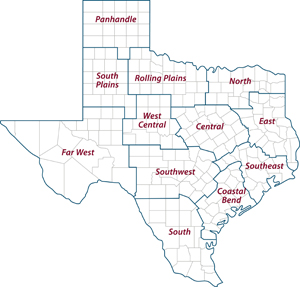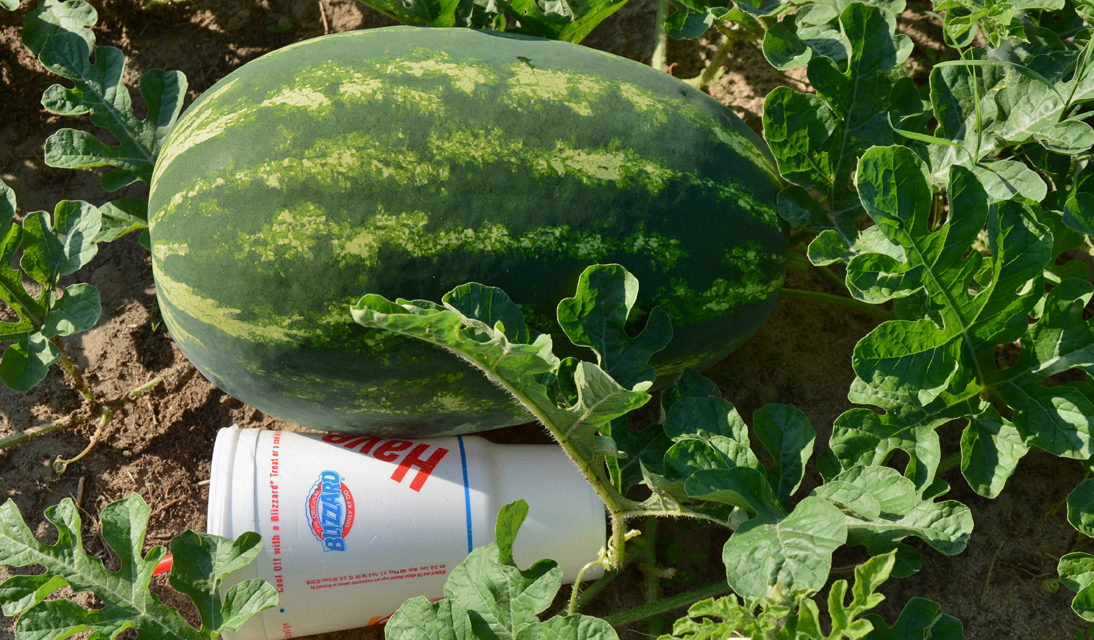By: Adam Russell
UVALDE – Despite typical troubles for individual growers, the Texas watermelon crop appears to be performing on time and without many problems, said Dr. Larry Stein, Texas A&M AgriLife Extension Service horticulturist, Uvalde.

Melvin Rutherford, a watermelon grower in Hawkins, said hot, sunny days over the next few weeks will have his 14-acre watermelon patch ready for Fourth of July festivities. (Texas A&M AgriLife Extension Service photo by Adam Russell)
Stein said the Texas watermelon crop was “looking good” and has avoided many of the disease problems that have plagued other crops this year.
“Watermelons have been one of the better crops we have around the Lower Rio Grande Valley,” said Stein. “Other crops have had to deal with black rot and other disease issues, but watermelons have done well as the weather turned drier.”
Melvin Rutherford, of Hawkins, surveyed his 14-acre irrigated watermelon patch and pointed out problems here and there.
Gophers chewed the roots of a plant in one row, killing it quickly. Another plant in another row showed tell-tale signs of mosaic virus. Watermelon shoots, twisted together by high winds earlier in the season, weren’t spreading out as they should on many rows. Blooms and small, thumb-sized melons lay half-covered in the sand after winds shook them off their shoots.
Crows and furry critters like coyotes and squirrels can also cause significant losses if not kept in check, but the most significant problem for Rutherford has been weather. Cool weather and cloudy, rainy days slowed melon growth in May, so it may be July 1 before he begins cutting melons for shade-tree peddlers who come as far away as Fort Worth and Louisiana to fill trailers with his Jubilee variety.
The ability to deliver vine-ripe watermelons to meet demands around Fourth of July festivities is critical, he said.
But there are also signs that the 2017 season may be taking a turn for the better. He has monitored the growth of one larger melon and it’s been packing on size and weight over the past six sunny days.
“You’re up against Mother Nature,” he said. “There are things you can do to minimize your losses, but in the end, it’s a gamble. Give me hot, sunny days and we’ll be alright.”
Stein said the main challenge for growers is to hit the window of opportunity that peaks with the Fourth of July holiday. Producers often start their fields too early or cool weather can delay growth and push a field’s ready date beyond the peak.
“The key is to have them ready before the Fourth of July,” he said. “When you can hit that market date you can do very well.”
Watermelons are a dish people enjoy in the heat of the summer, Stein said. Sales start as summer opens and then typically tail off by the end of August.
Texas is the top producer of watermelons in the nation, according to the U.S. Department of Agriculture National Agriculture Statistics Service, and represent the No. 1 vegetable crop in Texas, Stein said.

The 12 Texas A&M AgriLife Extension Service Districts
The statewide watermelon crop in 2016 was worth more than $75 million, according to AgriLife Extension annual reports. That is down 25 percent from more than $100 million in 2014.
Stein said the vegetable’s expanding root system and ability to adapt to dry conditions on dryland fields make much of the state good for watermelon production, though several areas, such as the Lower Rio Grande Valley, and North and East Texas, have higher concentrations of fields.
“Most of the state received good rains and no major issues this year,” he said. “If they can make the Fourth of July window, they should be fine.”
AgriLife Extension district reporters compiled the following summaries:
CENTRAL: Heavy rainfall was reported in some areas, and newly planted cotton may require replanting. Winds and higher temperatures began drying out the soil. Irrigated corn looked very good, but rains were about one week too late for dryland fields. The rain should still help yields. Grain sorghum and soybeans, haygrazer and coastal Bermuda grass fields were doing well. Abundant hay was expected in the next two weeks. Pasture growth increased due to rain and forage availability was great. Crops showed no signs of stress. Livestock conditions were excellent, and stockers were being shipped to market. Tanks were full. Fly numbers were increasing. Some sugarcane aphids were reported, but nothing too high yet. Almost all counties reported good soil moisture. Overall crop, rangeland and pasture conditions were good in all counties.
ROLLING PLAINS: Some counties reported good conditions after rainfall, while other counties reported diminishing cropland conditions due to no rainfall. Wheat harvests were nearing completion. Cotton and sorghum planting was ongoing. Cotton farmers who received limited rainfall had enough moisture to sprout the seed but have seen plants drying out. Pasture conditions were good in most areas except the counties with limited rainfall where pastures and rangeland were beginning to turn brown. Hot temperatures were in the forecast.
COASTAL BEND: Conditions were great for growing crops and grass. Recent rains were beneficial to crops, which were in excellent condition. Soil conditions were very wet which prevented growth regulator applications to some cotton fields. Grain sorghum was rapidly maturing. Headworms were a problem in grain sorghum. Corn began to dent and cotton has responded nicely to the good moisture. Herbicides continued to be applied to rangeland and pastures. Hay harvesting continued with average to below-average yields. Cattle were in good condition and calves were gaining well.
EAST: Scattered thunderstorms brought more rain to some areas of the district. Ponds and creeks were full. Pasture and rangeland conditions were fair to good with several counties reporting excellent conditions. Forage growth in pastures and hay fields was good with adequate moisture, temperatures, and sunshine. Hay harvests continued. Weed control was in full swing as conditions were good to spray. Subsoil and topsoil conditions were adequate in all counties except Shelby County where conditions were reported as surplus. Many producers were reporting armyworm infestations in Cherokee and Smith Counties. Smith County also had reports of grasshoppers in fields. Corn was 100 percent emerged in Houston County and was in fair to good condition. Onions, tomatoes, and squash were being harvested in Smith County. Cattle were in good to excellent condition. Weaning and selling of market-ready calves and cull-cows continued in Polk County. Cattle prices slipped a little in Gregg County markets and remained solid in Shelby County. Wild pig reports were increasing.
SOUTH PLAINS: Some fields received spotty rain showers. However, a general rain was needed to provide relief from hot, windy conditions. Most cotton fields were up to a stand, except for some non-irrigated fields that did not have enough moisture to germinate the seed. Field operations included completion of planting and emergency tillage to prevent blowing sand. Wheat harvests continued. Irrigated corn was in good condition and progressing well. Pastures and rangeland were in fair to good condition. Cattle were in good condition.
PANHANDLE: Conditions were hot, dry and windy. Temperatures were near normal for most of the district. Moisture was received late in the reporting period in some areas. Hansford County received 1.34 inches of rain in the northeast and southern portions of the county. Some rain mixed with pea-sized hail was received in the western portion of the county. Deaf Smith County producers were delaying harvest on some corn acres and running pivots hard and fast. Daytime temperatures were in the high 90s to low 100s, so water use was increasing. Wheat harvests were right around the corner with some producers sampling their dryland fields. Some producers were concerned with wheat that looked great but has little wheat in the heads. Some corn and sorghum was being planted. All planted corn and cotton has emerged. Cattle looked good on lush, green grass. Ochiltree County corn, cotton and soybean planting was complete except for a few scattered fields.
NORTH: Topsoil and subsoil moisture levels were mostly adequate. Hard rains fell with rainfall amounts of 1-4 inches. Nighttime temperatures were in the high 60s and has Bermuda grass growing well. Pastures, corn and sorghum all looked very good. Wheat and hay were being harvested. Yield reports indicate a slightly above average yield for wheat. Fly numbers on horses and cattle were increasing. Wild pig activity was pretty high.
FAR WEST: Temperature highs were in the 100s with lows in the 50s. Precipitation reported for the week averaged 0.3 of an inch with severe lightning reported. Cotton made amazing progress. Dryland cotton was drying out. High winds and hot temperatures sucked the moisture out of the top 8-12 inches of soil. Wheat harvests were nearing completion and several producers reported good yields but low prices. Sorghum and corn were off to a good start. Corn was nearing tassel and sorghum was nearing boot stage. Aside from needing rain, there were no major crop issues.
WEST CENTRAL: The weather was warm, windy and humid with average temperatures. Soil moisture was adequate but was expected to dry out soon due to heat and winds. Wheat harvests were near completion. Cotton planting was in full swing. Farmers worked through the weekend to get everything planted while they had sufficient topsoil moisture. Planted cotton was off to a good start with adequate moisture. Another good rain would be good for all crops. Irrigated sorghum and corn looked great, but dryland fields were looking poor. Cutting and baling of Bermuda grass hay was underway. Ranchers were checking on prussic acid in grasses. Rangeland and pasture conditions were mostly good and growing due to recent rains. Insect pest problems were increasing. Most stock tanks were full from recent rain runoff. Livestock remained in mostly fair to good condition. Prices remained steady at cattle auctions. Pecan crops were off to a promising start.
SOUTHEAST: Rice was still being planted. Livestock in Fort Bend County were in good condition, but the fields were drying. Most fields in Brazos County were extremely wet. Some areas received 1-2 inches of rain, and fields responded accordingly. Fertilized fields were in good shape. In the last 10 days, many fields were harvested for hay. Temperatures were very hot. Soil-moisture levels throughout the district ranged from adequate to surplus with mostly adequate ratings.
SOUTHWEST: No report was provided.
SOUTH: Temperatures were hot with reports well over 90 degrees and into the triple digits in a few areas. Crop production was active throughout the district. Some areas received scattered showers and reported high humidity levels. Rainfall amounts were up to 1 inch. Other areas were hot and dry. Potato and table corn harvests continued. Peanut planting was in full swing and expected to be complete soon. Row crops progressed very rapidly with recent rains. Significant improvements were noted on late-planted sorghum fields and cotton. Cotton was squaring in some areas. Sorghum was heading in some areas. Hidalgo County producers harvested sunflowers and prepared sorghum for harvest. Corn was starting to mature. Pasture and rangeland conditions were good after recent rainfall but remained mostly in fair shape in areas with declining moisture and increased temperatures. Body condition scores on cattle remained good. The live-cattle market was on the rise for the past couple of weeks and maintained its upward trend. Rains continued to support excellent grazing and habitat conditions for wildlife. Rains were not significant enough to replenish livestock tanks. Coastal Bermuda grass crops were in good condition and producing good amounts of hay. Zavala County finally had a rain-free week that helped dry out fields and allow the harvest of the remaining wheat fields. Weed problems were reported in pastureland and row crop fields in southern parts of the district.





